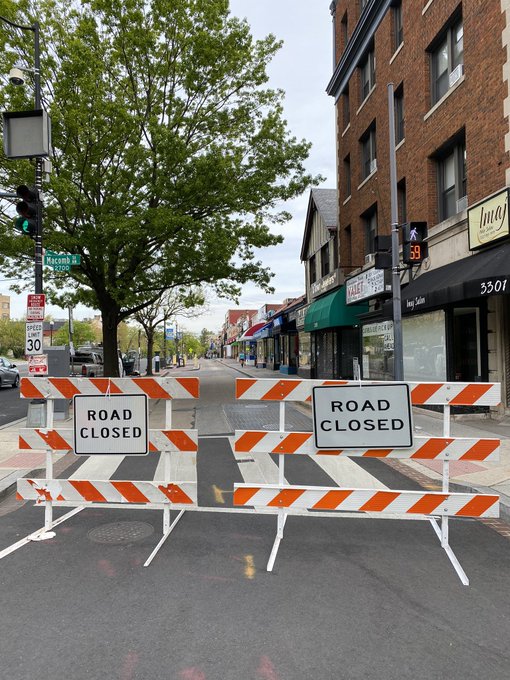Curbside management in a recurring emergency scenario: A municipal perspective

A service lane in the Cleveland Park neighborhood in Washington, DC.
This post is part of a special series on curb management and COVID-19. A joint effort of the Institute for Parking and Mobility, Transportation for America, and the Institute of Transportation Engineer’s Complete Streets Council, this series strives to document the immediate curbside-related actions and responses to COVID-19, as well as create a knowledge base of strategies that communities can use to manage the curbside during future emergencies. Check out the last post.
By Benito O. Pérez, AICP CTP, CPM; and David Carson Lipscomb, MCP
For all of us, 2020 will be the year the world changed. Seemingly overnight the hustle and bustle of life and commerce in our cities went nearly silent under government-mandated shelter-in-place orders aimed to stop the spread of COVID-19. Overwhelmed healthcare networks and essential businesses that help meet our most basic needs were thrown into crisis. This is a common reality after natural disasters like hurricanes, earthquakes, and floods. However, unlike those events, this is simultaneously a prolonged and global experience.
Municipal governments are vital to protecting our communities, tasked with coordinating resources to address this public health emergency while maintaining order and normalcy for residents. Curbside and parking professionals across the country have supported their municipal responses by ensuring prioritized, optimal transportation network operations in innovative, rapid-response ways including the following.
- Restaurant pick-up zones. With dine-in operations banned, restaurants shifted to takeout/delivery models resulting in congestion at the curb for customers and couriers. Originating in Seattle and propagating rapidly across the country, municipalities reprogrammed segments of their curbside with temporary signage coupled with information campaigns (like the District of Columbia map) showing curbs prioritized for pick-up activity. This ensured curb turnover while supporting local restaurants.
- Relaxed curbside enforcement. Shelter-in-place orders led to more stationary vehicles, which put them in violation of policies encouraging turnover. Cities like Miami, Pittsburgh, and others relaxed parking enforcement to discourage unnecessary community movement.
- Suspended parking space payment. Some communities suspended parking payment, though they did not make that decision lightly. In many jurisdictions, parking revenue is the operational funding lifeblood of their organizations. For the District, it’s about 10 percent of its annual contribution to the regional transportation system. However, costs to maintain parking payment far outweighed anticipated revenue. Additionally, reducing potential sources of infection, i.e., parking payment kiosks, was also of concern for municipal operators.
- Prioritized/designated essential service provider parking. Hospitals have been the front lines of this pandemic, with many facilities converting off-street parking lots and garages to triage and community testing sites. With limited public transportation services and scarce access to for-hire vehicles as drivers limit their exposure, some healthcare providers are resorting to private vehicles. With on-site parking gone, municipalities have designated curbsides near medical facilities for healthcare facility employees. New York City has issued healthcare provider parking permits to allow them to park wherever is most convenient. This may become an extended concern for other essential service staff in dense, urban areas with limited transit.
- Expanded sidewalks. In urban areas in particular, sidewalks are constrained by historical rights of way. That means there may be sidewalks narrower than the minimum six feet recommended by the Centers for Disease Control and Prevention’s “physical distancing” guidelines. Places like New York City have cleared the curb, if not the entire roadway, to facilitate unimpeded, “physically distant” pedestrian routes.
These are but a few strategies that are part of cohesive and holistic community responses to the COVID-19 pandemic. If you have a good story, please share it with benito.perez@dc.gov.
Benito O. Pérez is the curbside management operations planning manager at the District Department of Transportation in Washington, D.C.
David C. Lipscomb is a curbside management planner at the District Department of Transportation in Washington, D.C.




















Pingback: What Do We Do Next?: COVID-19 and the Triple Helix Model of Innovation
Pingback: Transportation For America What do we do next? COVID-19 and the triple helix model of innovation - Transportation For America
Pingback: What do we do next? COVID-19 and the triple helix model of innovation | Public Transit Blog